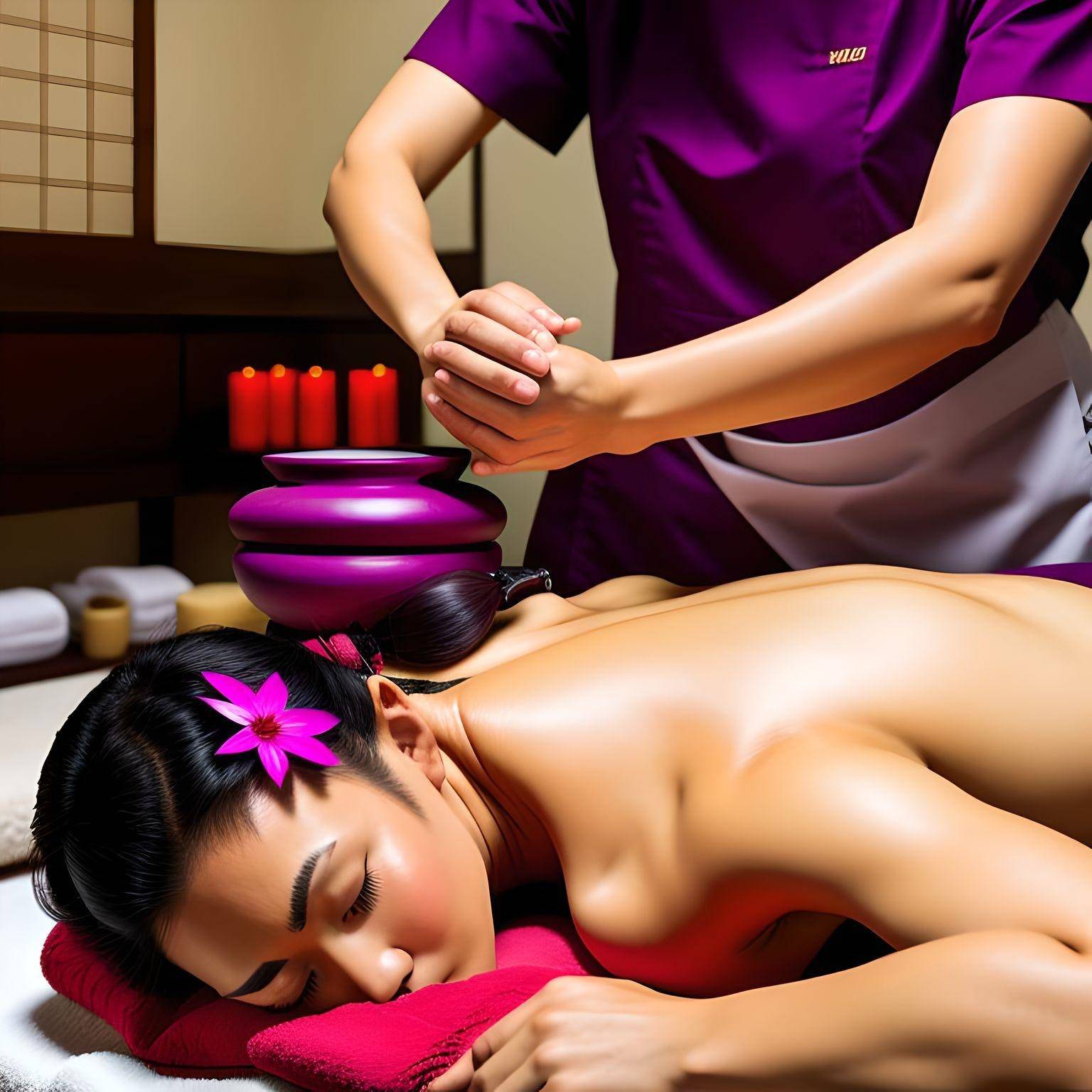
Ever wondered how the ancient art of Japanese massage can transport you to a world of relaxation and rejuvenation? Look no further! Japanese massage, with its rich origins dating back centuries, is more than just physical therapy. It embodies a unique blend of cultural significance and healing principles that have stood the test of time.
Rooted in traditional Eastern practices, Japanese massage follows key principles that prioritize harmony between mind, body, and spirit. By incorporating techniques like Shiatsu and Anma, practitioners aim to restore balance and alleviate tension through targeted pressure points. But it doesn’t stop there – Japanese massage goes beyond physical relief; it delves into the very essence of cultural heritage.
With each stroke and knead, this therapeutic practice embraces the holistic nature of well-being while honoring Japan’s deep-rooted traditions. So why not immerse yourself in an experience that combines ancient wisdom with modern-day relaxation? Discover the wonders of Japanese massage and embark on a journey toward tranquility like never before.
Understanding the Benefits of Japanese Massage
Japanese massage offers a range of benefits that promote stress reduction, relaxation, and overall well-being. This ancient practice focuses on specific techniques that target various areas of the body to provide relief from muscle tension and pain. By improving blood circulation and lymphatic flow, Japanese massage enhances the body’s natural healing process.
-
Stress reduction and relaxation: Japanese massage techniques, such as shiatsu and anma, help release tension in both the muscles and mind. Through gentle pressure applied to specific points on the body, it promotes deep relaxation and reduces stress levels.
-
Improved blood circulation and lymphatic flow: The precise movements involved in Japanese massage stimulate blood flow throughout the body. This increased circulation helps deliver oxygen and nutrients to cells while removing waste products more efficiently. It stimulates lymphatic flow, which aids in detoxification by eliminating toxins from tissues.
-
Relief from muscle tension and pain: One of the primary benefits of Japanese massage is its ability to alleviate muscle tension and pain. Techniques like kneading, stretching, and acupressure target tight or sore muscles, promoting their relaxation and reducing discomfort.
Japanese massage combines ancient wisdom with modern understanding of anatomy to provide a holistic approach to wellness. Its benefits extend beyond physical relief; they also contribute to mental well-being by promoting a sense of calmness and rejuvenation.
So if you’re seeking stress reduction, improved circulation, or relief from muscle tension, consider incorporating Japanese massage into your self-care routine. Experience its therapeutic effects firsthand as you indulge in this time-honored practice that nurtures both body and mind.
Exploring Different Techniques in Japanese Massage
- Shiatsu: Focusing on pressure points
Shiatsu massage technique involves applying pressure to specific points on the body to promote relaxation and relieve tension. This technique aims to balance the body’s energy flow, known as “qi,” by targeting meridian lines and acupressure points. By using fingers, palms, elbows, or even feet, a shiatsu practitioner can stimulate these points and release any blockages in the energy pathways.
- Anma: Utilizing kneading and tapping motions
Anma massage is characterized by its use of kneading and tapping motions. Practitioners apply rhythmic pressure with their hands, thumbs, and palms to manipulate soft tissues such as muscles and tendons. This technique promotes blood circulation, eases muscle stiffness, and enhances overall relaxation. Anma massage often incorporates various strokes like rubbing, pressing, rolling, and percussive movements.
- Seitai: Incorporating joint manipulation and stretching
Seitai massage combines elements of chiropractic adjustments with traditional Japanese techniques. It focuses on aligning the spine and joints while incorporating gentle stretches to improve flexibility. The practitioner may use manual manipulations or gentle pressure to realign misaligned vertebrae or joints. Seitai aims to restore balance within the body’s structure for enhanced well-being.
Examining the Potential Side Effects of Japanese Massage
Japanese massage, also known as “anma,” has gained popularity for its ability to promote relaxation and alleviate muscle tension. While it offers numerous benefits, it is essential to be aware of potential side effects and risks associated with this practice.
Temporary soreness or bruising
After a Japanese massage session, some individuals may experience temporary soreness or bruising. The vigorous manipulation techniques used during the massage can occasionally lead to mild discomfort. However, these effects are typically short-lived and subside within a few days.
Risk of injury if performed incorrectly
Japanese massage involves applying pressure to specific points on the body, which requires skill and expertise. If performed incorrectly or by an untrained individual, there is a risk of injury. It is crucial to seek out a qualified practitioner who understands the proper techniques and precautions involved in Japanese massage.
Contraindications for certain medical conditions
While Japanese massage can be beneficial for many people, there are certain medical conditions that may make it unsuitable or require modifications. Individuals with severe osteoporosis, fractures, open wounds, infectious skin conditions, or recent surgeries should avoid or consult their healthcare provider before undergoing Japanese massage.
Considering the potential side effects and risks associated with Japanese massage is important for making an informed decision about whether it is suitable for you. Reading reviews from others who have experienced this type of massage can provide insights into their personal experiences and any side effects they may have encountered.
It’s essential to prioritize your safety when exploring different forms of therapy like Japanese massage. By being aware of the possible side effects, understanding the risks involved in incorrect execution, and considering contraindications for specific medical conditions, you can make an informed choice about incorporating this practice into your wellness routine.
Who Can Benefit from Japanese Massage?
Japanese massage, also known as “shiatsu,” offers a range of benefits for various individuals. Whether you’re dealing with chronic pain, stress-related symptoms, or seeking to enhance athletic performance and recovery, Japanese massage can be an effective solution.
- Individuals with Chronic Pain or Musculoskeletal Issues
If you’re struggling with chronic pain or musculoskeletal issues, Japanese massage can provide much-needed relief. By applying pressure to specific points on the body, this technique helps alleviate tension and promote relaxation. It targets areas affected by pain or discomfort, such as the back, neck, shoulders, and joints. Through gentle manipulation and stretching techniques, Japanese massage aims to improve circulation and release muscle tightness.
- People Experiencing Stress-Related Symptoms like Anxiety or Insomnia
For those experiencing stress-related symptoms like anxiety or insomnia, Japanese massage can offer a calming effect on both the mind and body. The rhythmic pressure applied during the massage stimulates the release of endorphins and promotes relaxation. This can help reduce anxiety levels and improve sleep quality by inducing a state of deep relaxation.
- Athletes Looking to Enhance Performance and Recovery
Athletes often turn to Japanese massage as part of their training regimen to optimize performance and aid in post-workout recovery. This type of massage focuses on targeting specific muscle groups involved in sports activities. By increasing blood flow to these areas and reducing muscle tension, it helps prevent injuries while improving flexibility and range of motion. Japanese massage aids in flushing out metabolic waste products from muscles post-exercise, allowing for faster recovery.
Making Japanese Massage Accessible: Cost and Home Options
Affordability compared to other types of massages
Japanese massage, also known as “shiatsu,” offers an affordable alternative to other types of massages. Unlike expensive spa treatments or deep tissue massages, Japanese massage focuses on applying pressure to specific points on the body to relieve tension and promote relaxation. This cost-effective approach allows individuals to experience the benefits of a professional massage without breaking the bank.
DIY techniques for self-massage at home
If you’re looking to save even more money, there are various DIY techniques for self-massage that you can try at home. These simple yet effective methods allow you to experience the rejuvenating effects of Japanese massage without leaving your house. Here are some options:
-
Finger pressure: Apply gentle pressure using your fingers or thumbs on specific areas of your body, such as the neck, shoulders, or feet.
-
Palm pushing: Use the palm of your hand to apply steady pressure in circular motions on different muscle groups.
-
Stretching exercises: Incorporate stretching into your daily routine to release tension and improve flexibility.
By exploring these DIY techniques, you can enjoy the benefits of Japanese massage conveniently within the comfort of your own home.
Tips for finding affordable professional services
While practicing self-massage at home is a great option, sometimes it’s nice to treat yourself with a professional Japanese massage. To find affordable services near you, consider these tips:
-
Local community centers: Check if community centers offer discounted rates for Japanese massage sessions.
-
Student clinics: Look for student clinics where trainees offer supervised massages at reduced prices.
-
Group discounts: Gather friends or family members who are interested in Japanese massage and inquire about group discounts at local spas or wellness centers.
By exploring these avenues, you can discover cost-effective ways to access professional Japanese massage services without straining your budget.
Embracing the Healing Power of Japanese Massage
Japanese massage offers a multitude of benefits for your overall well-being. By understanding these benefits, exploring different techniques, and examining potential side effects, you can make an informed decision about whether Japanese massage is right for you.
One of the key advantages of Japanese massage is its ability to promote relaxation and reduce stress. This ancient practice utilizes various techniques such as Shiatsu and Anma to release tension in your muscles and improve blood circulation. It can help alleviate pain, improve flexibility, and enhance your body’s natural healing processes.
It’s important to note that while Japanese massage generally has minimal side effects, some individuals may experience temporary soreness or bruising. It’s always wise to consult with a qualified practitioner before undergoing any form of massage therapy.
Japanese massage is suitable for a wide range of people seeking physical and mental relief. Whether you’re struggling with chronic pain, recovering from an injury, or simply looking for a way to unwind after a long day, this therapeutic practice can benefit you.
To make Japanese massage accessible, there are cost-effective options available such as community clinics or training centers where students provide supervised treatments at reduced rates. You can explore self-massage techniques that can be performed at home using simple tools like foam rollers or tennis balls.
In conclusion, embracing the healing power of Japanese massage can significantly improve your well-being by reducing stress levels, alleviating pain, and promoting relaxation. Consider incorporating this ancient practice into your wellness routine today!
FAQs
- Can anyone receive a Japanese massage?
Yes! Japanese massage is suitable for most individuals seeking physical and mental relief. However, it’s recommended to consult with a qualified practitioner if you have specific health concerns or medical conditions.
- How often should I get a Japanese massage?
The frequency of Japanese massages depends on your individual needs and preferences. Some people find benefit in weekly sessions while others opt for monthly or occasional treatments. Listen to your body and adjust accordingly.
- Is Japanese massage painful?
Japanese massage techniques can sometimes involve deep pressure, which may cause temporary discomfort. However, it should not be excessively painful. Communication with your practitioner is key to ensure your comfort during the session.
- Can Japanese massage help with specific conditions like back pain or headaches?
Yes, Japanese massage techniques have been known to provide relief for various conditions such as back pain, headaches, and muscle tension. However, results may vary depending on the individual.
- How long does a typical Japanese massage session last?
The duration of a Japanese massage session can vary but typically lasts between 60 to 90 minutes. This allows sufficient time for the therapist to address your specific needs and provide a thorough treatment.





